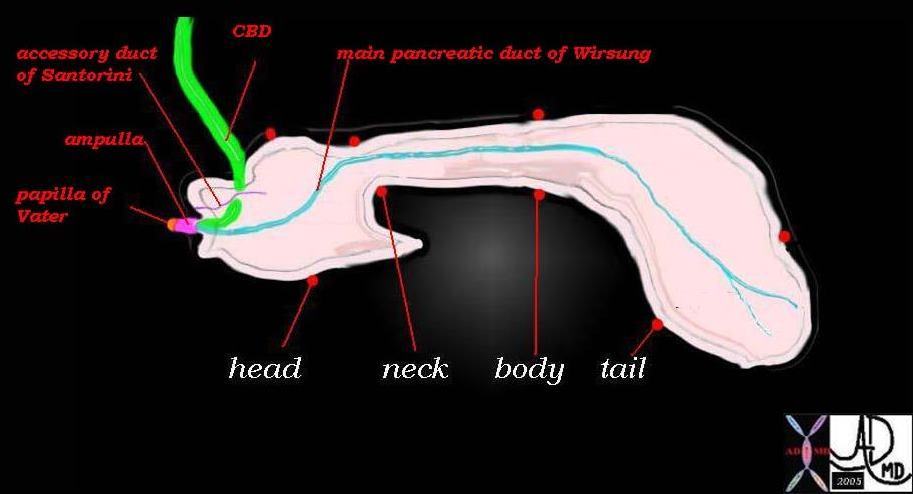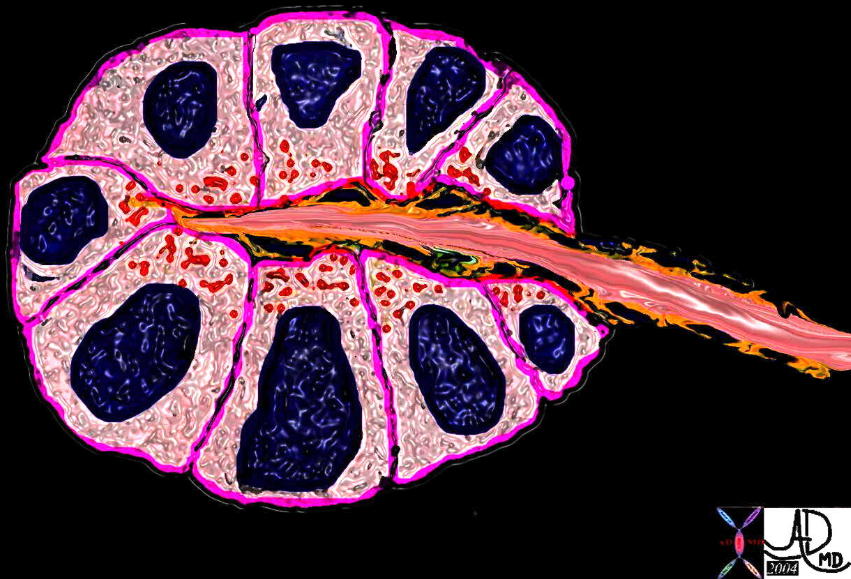|
The word pancreas derives from the Greek words “pan” meaning “all “and “kreas” meaning “meat “ since it was thought to be made of muscle. It is however not a muscle but an elongated glandular structure that is soft and fleshy, and is situated in the retroperitoneum behind the stomach and the duodenum. It secretes pancreatic enzymes into the duodenum which aid in the digestion of fat and proteins, and it is a key player in the control of glucose metabolism which it accomplishes by secreting insulin into the circulation. It thus functions as both an as an exocrine gland (secretes into ducts) and an endocrine gland (secretes into the circulation).The pancreas was known as the “hermit of the abdomen” since it was considered for many years a mysterious and lonely figure that lay deep in the abdomen. Over the years, knowledge of the function of the pancreas evolved, but it is only in recent years with the advent of and advances in angiography, ultrasound, CT and MRI that it’s in vivo structure has become understood. It is well connected to many organs, and is central to many functions and structures. Together with the“all meat” misnomer its status as “ hermit of the abdomen” are mere historic curiosities at this time. In this section we present a perspective of the gland by exploring the principles that govern the gland hoping to give a perspective of its common structural and functional features. We explore the variety of classifications of the gland which gives us a perspective of where it lies in respect to the other structures. The historical perspective, gives us a sense of the evolution of our knowledge base, lest we take that for granted. We conclude with some general comments oclassifications advance the knowledge of structure and function, the basics structure and function of the anatomy and we add to that an overview of the gland at large including the physiology histology, diagnostic arts and therapy.
As a structure Every structure can be described with having a characteristic size, shape, position, and character or nature. Whether we are discussing the structure at a subcellular, cellular, histological, or macroscopic level, these descriptive principles will pertain. Similarly when these features change in disease, we will recognise this disease when we identify a change in any or all of these parameters. It is therefore of extreme importance that we know or have access to the normal features of the cells and organs of the body if we want to be able to detect disease. The enlargement of an organ is a classical example of how we identify disease. A colon that is enlarged or dilated in its upstream portion and decompressed in its downstream portion will imply that there is an obstruction. The recognition of these structural changes are the key elements of diagnosis in clinical medicine and in radiology. Similarly a mucosal cell that is too large will also reflect aberrance in the cell and together with other features of structural change such as an alteration in the way the cell appears with different staining techniques, will be aids to the pathologist of a more specific diagnosis. While size, shape, and position in space are easy descriptors to understand, characater needs a tad more discussion. Newton described that for every action there is an equal and opposite reaction. In other words if you do something to a cell, tissue or an organ or even a person, you will get a reaction. If for example you press your finger on the liver you will be able to describe the liver as being rubbery, soft or hard. Now the liver normally is a fairly soft organ, and if you notice that it is hard then you will have noticed a character change and this will be a clue that the liver is abnormal and a hunt for a relevant diagnosis and therefore a relevant therapy will be the function of the physician. The stains that are used by pathologists are a way of interrogating the character of a cell or a tissue. By applying a staining technique the pathologist challenges the cell to see how it will react to the stain and in so doing is able to characterise the cell. Radiologists will subjet the organs to X-ray interrogation, ultrasound waves or electromagnetic fields and magnets in an attempt to explore how the tissues react to the challenge. Thus if a patient undergoes a chest X-ray, the X-rays are accelerated through the chest, and the image reflects how the tissue has reacted to the waves. Thus normal lung tissue will offer little resistance to the X-rays as they pass through , while bone on the other hand will offer significant resistance. The lungs appear black on the image and the bones appear white reflecting the reaction of these tissues to the X-ray path and thus their distinguishing characteristics. The liver and other “soft tissues” of the body will offer an intermediate resistance to the X-rays and therefore will appear gray. A mass in the lung will offer a “soft tissue” resistance to the path and will present as a gray structure where black air should have been. This reflects a change in the character of lung and is the first clue that all is not well with the patient. The characater of a person is also gauged as to how they react to a given situation or provocation. If you for example press your finger on persons nose (the way you pressed on the liver) the reaction will represent in some measure their nature. Of course humans do not have the same black and white action reaction cycle, but the principles apply.
PRINCIPLES
As an Endocrine gland As an endocrine gland, the pancreas is endowed with a rich blood supply since it has to secrete the hormones it produces into the circulation in order for the hormones to have a rapid effect. The islets of Langerhans secrete insulin into the blood stream, very soon after ingestion of a meal in order to control blood sugar and intracellular glucose concentrations. The endocrine cells called the islets of Langerhans represent only 1-2% of the tissue volume of the pancreas, but play a vital role in body function and well being. They are most numerous in the tail of the pancreas. As a serous exocrine gland, the pancreas has to have an accompanying ductal system. The epithelial cells secrete a fluid containg the enzymes into the pancreatic duct which is a tube and as such, is subject to the the laws that govern flow in a tube. Some of the factors that need consideration relating to flow include the radius of the tube, the pressure differences between the upstream side and the downstream side of the tube, viscocity of the medium that is being transported and the friction that occurs between the fluid being transported and the lining of the tube. The pancreatic fluid has a relatively low viscocity, and is rich in sodium and bicarbonates. The bicarbonates neutralise the acid in the gastric juices that enter the small bowel as chyle in order to optimise the PH for enzyme function. About one litre of fluid is produced and transported per day.
As an endocrine gland the pancreas secretes its hormones directly into the blood stream with almost immediate effect on the body. For this aspect to function optimally there has to be a rich blood supply to and from the gland. The pancreas has an exteremely rich blood supply supplied by both the celiac axis and the SMA.
As a physiological structure
As a phyiological structure it has to obey the rules of supply and demand which it executes through both simple and complex neurohormonal reflexes. A reflex consistsof a component that is able to sense, a component that integrates and controls the reflex, and a compoonent that is able to execute change. The sensors are in the form of chemical and mechanical sensors. The controlling bodies are at a spinal level, autonomic level, and also at cortical level. The aspects that execute change are at the level of the muscle and glands. The body can basically perform two functions. It can contract and secrete. It is astounding that through these two processes we have been able to advance humanity to the extent that we have. |


 The pancreas consists of two types of glands. The exocrine type is demonstrtaed above consisting of an epithelium in the form of a rosette that secretes functional material into a duct. The rosette of gland is rounded in 3D in the form of an acinus. 39939b04 Courtesy Ashley Davidoff MD
The pancreas consists of two types of glands. The exocrine type is demonstrtaed above consisting of an epithelium in the form of a rosette that secretes functional material into a duct. The rosette of gland is rounded in 3D in the form of an acinus. 39939b04 Courtesy Ashley Davidoff MD The pancreas has an exocrine and endocrine component. The exocrine compnent is demonstrated above in 3D with acini in “cluster of grapes” formation subtended by a duct. Courtesy Ashley Davidoff MD 32645a06
The pancreas has an exocrine and endocrine component. The exocrine compnent is demonstrated above in 3D with acini in “cluster of grapes” formation subtended by a duct. Courtesy Ashley Davidoff MD 32645a06